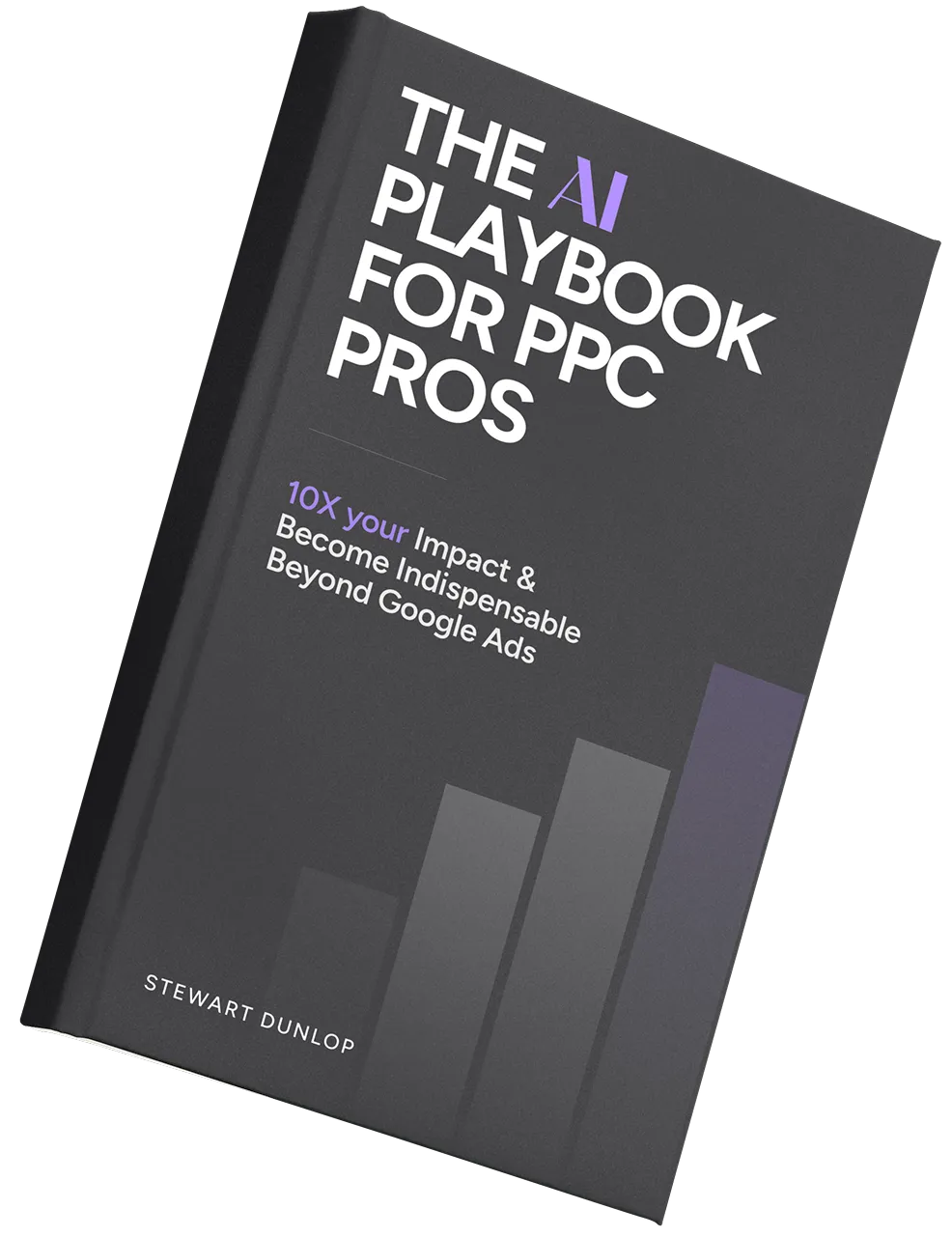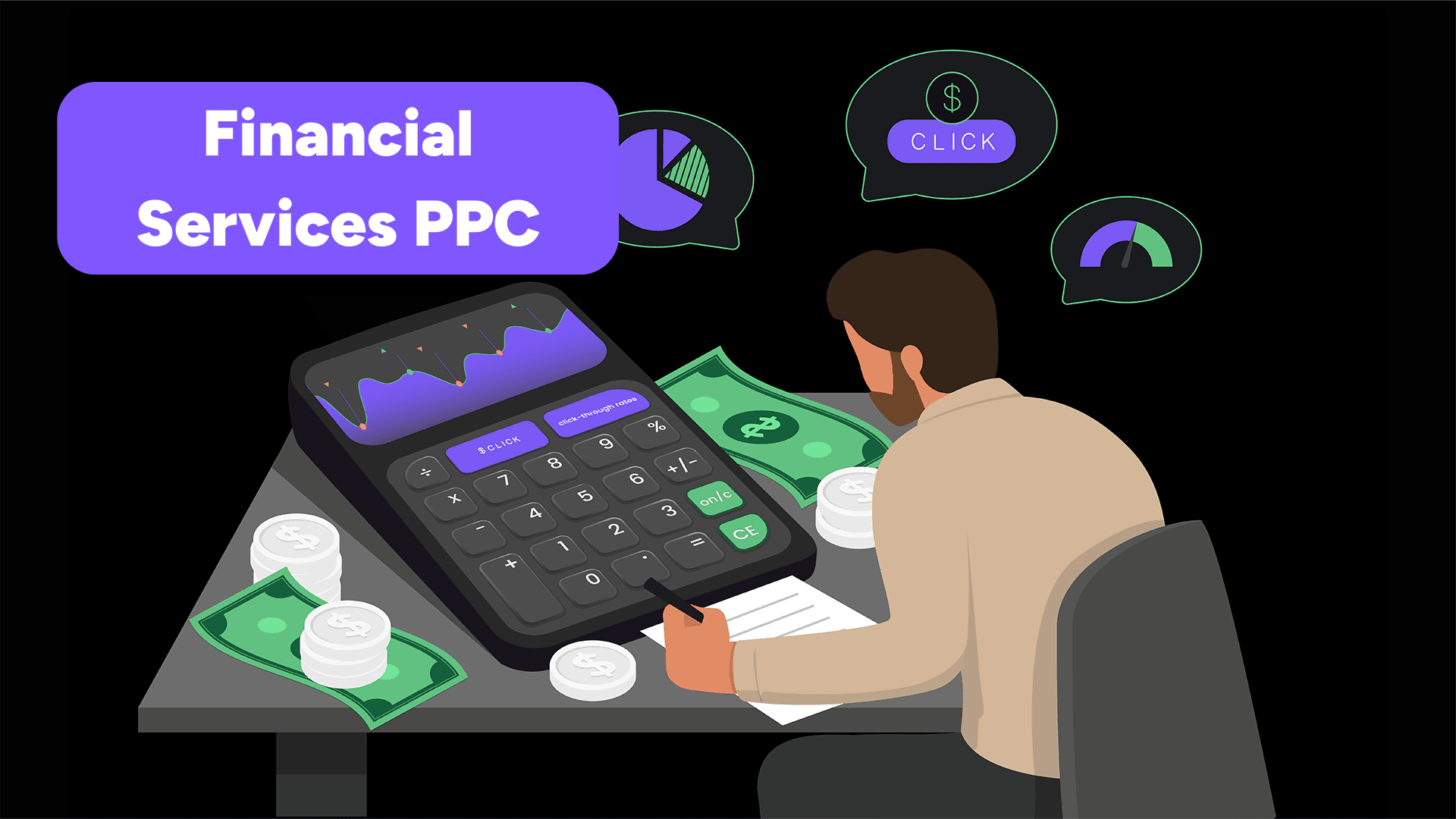
PPC is arguably the most predictable growth channel for financial services companies.
Yes, competition is fierce, but it’s the incredible opportunity to target people who are ready to buy your service that’s just too good to overlook.
Some quick numbers on Google searches:
🌐 90% of loan and mortgage consumers search online to assess their options.
🌐Mobile searches for “What should I invest in?” increase by 65% each year.
🌐Mobile searches for “bank near me” have grown by over 60%.
🌐Over 50% of offline investors gather information online first.
What Is PPC for Financial Services?
Most consumers begin their buying journey with a Google search.
A potential customer will type a question into a search engine, like Google, to find a product or service that fulfills their need. This is where PPC ads come in.
By bidding on relevant keywords related to these searches, your ads can appear at the top of the search results. The goal is to ensure search engines choose to show your ad to as many potential customers as possible.
Then, once the user lands on your website, it’s up to you to get them to convert.
You can see examples of PPC ads when you search for “mortgage lender Arizona” on Google:
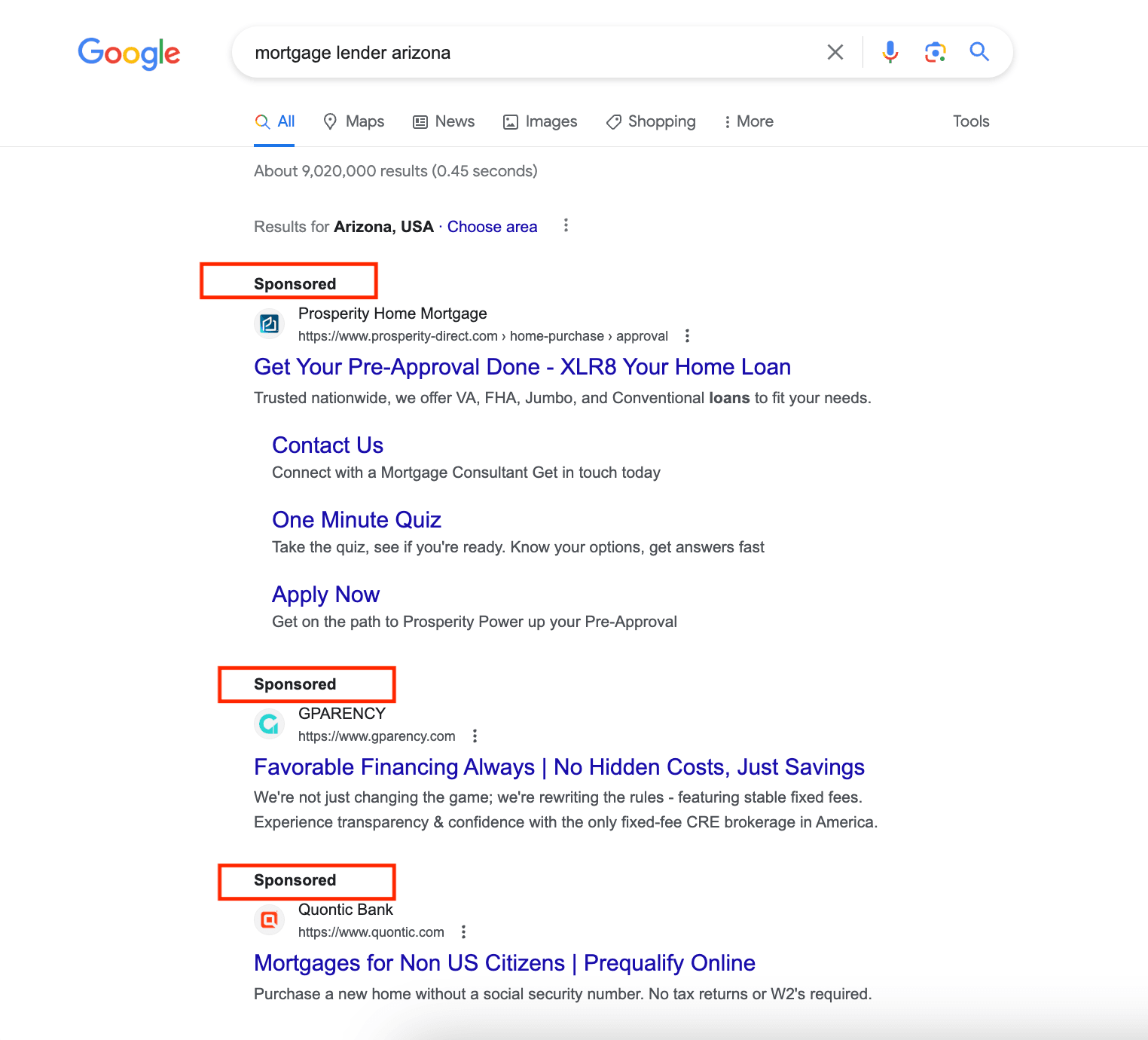
All three of the top results are PPC ads. If potential customers click on one of these ads, the financial business that the ad belongs to will pay a fee.
If a user doesn’t click on it, you don’t pay.
PPC advertising gives you the chance to appear at the top of Google search results.
This helps your financial services business to:
- Reach your target audience with the power of keyword targeting.
- Driving online applications and inquiries.
- Retargeting customers who haven't converted.
- Maximize return on investment (ROI).
- Measuring and analyzing performance.
- Leverage the incredible AI-powered tools of Google to get you customers.

How Does PPC Advertising Work in the Finance Industry?
💡 Google Advertising Policies
In Google’s advertising policy, it states:
“We want users to have adequate information to make informed financial decisions.
Our policies are designed to give users information to weigh the costs associated with financial products and services, and to protect users from harmful or deceitful practices.”
Promoting financial services through PPC advertising can be intricate.
If you have a financial business, Google will assess your ads and landing pages to make sure your practices align with their policies.
Here are some of the guidelines Google has in place for the financial services industry:
➡️ High APR personal loans
Google states its advertisers must protect users from misleading or harmful products, especially ultra-high-cost personal loans.
In the U.S., Google does not allow PPC advertising for personal loans when the annual percentage rate (APR) exceeds 36%.
This policy extends to advertisers who directly offer loans, lead generators, and intermediaries who connect consumers with third-party lenders.
➡️ Loan modification
A loan modification is when a lender agrees to alter the terms of a borrower's loan, usually because the borrower is struggling to make payments. These changes may include lowering the interest rate, extending the time to repay, or reducing the principal amount owed.
Advertisers dealing in loan modification must follow certain rules to ensure transparency and protect consumers.
Here’s what these guidelines mean for loan modification ads:
❌ You can’t guarantee loan modification or foreclosure prevention.
❌ You can’t charge upfront fees unless you’re a licensed law firm.
❌You can’t suggest users sell their homes below market price.
❌ You can’t encourage users to bypass their lenders.
❌ You can’t discourage users from contacting other financial service providers.
➡️ Binary options
Binary options are a financial instrument that allows individuals to speculate on the price movement of various underlying assets, such as stocks, currencies, or commodities. You're essentially betting on whether something will or won't happen within a set period.
For example, you might bet that Company A's stock price will be above $100 at the end of the trading day. If you're right and it is higher, you make money. If you're wrong and it's lower, you lose what you bet.
It's called "binary" because individuals can only win or lose—there's no in-between.
Google's regulations are designed to protect investors in the following ways:
❌ You can’t advertise binary options
Advertisers aren’t allowed to promote binary options or similar financial products.
This includes paid search ads for digital options, binary options, digital 100, fixed return options, and all-or-nothing options.
➡️ Complex speculative financial products
Advertisers can only promote complex speculative products when they meet Google’s criteria.
In the U.S., these ads are only allowed under certain conditions.
These are the types of products these rules cover:
- Contract for difference (CFD).
- Financial spread betting.
- Rolling spot forex (often referred to simply as "Forex" or "FX").
- Related forms of speculative products.
To advertise these products, financial businesses must comply with local laws and industry standards, such as being licensed by the National Futures Association (NFA) or being registered with FinCEN as a money services business (MSB).
Your advertising account must also be certified by Google to run PPC campaigns.
➡️ Credit repair services
Ads for credit repair services are not allowed. This is to ensure consumers make informed decisions about addressing bad credit.
This policy applies to advertisers who offer credit repair services directly, lead generators, and financial services companies that connect consumers with third-party credit repair services.
➡️ Debt services
Ads for debt settlement services or debt management services can only be shown in the U.S. when the services adhere to local laws, industry standards, and Google's certification process.
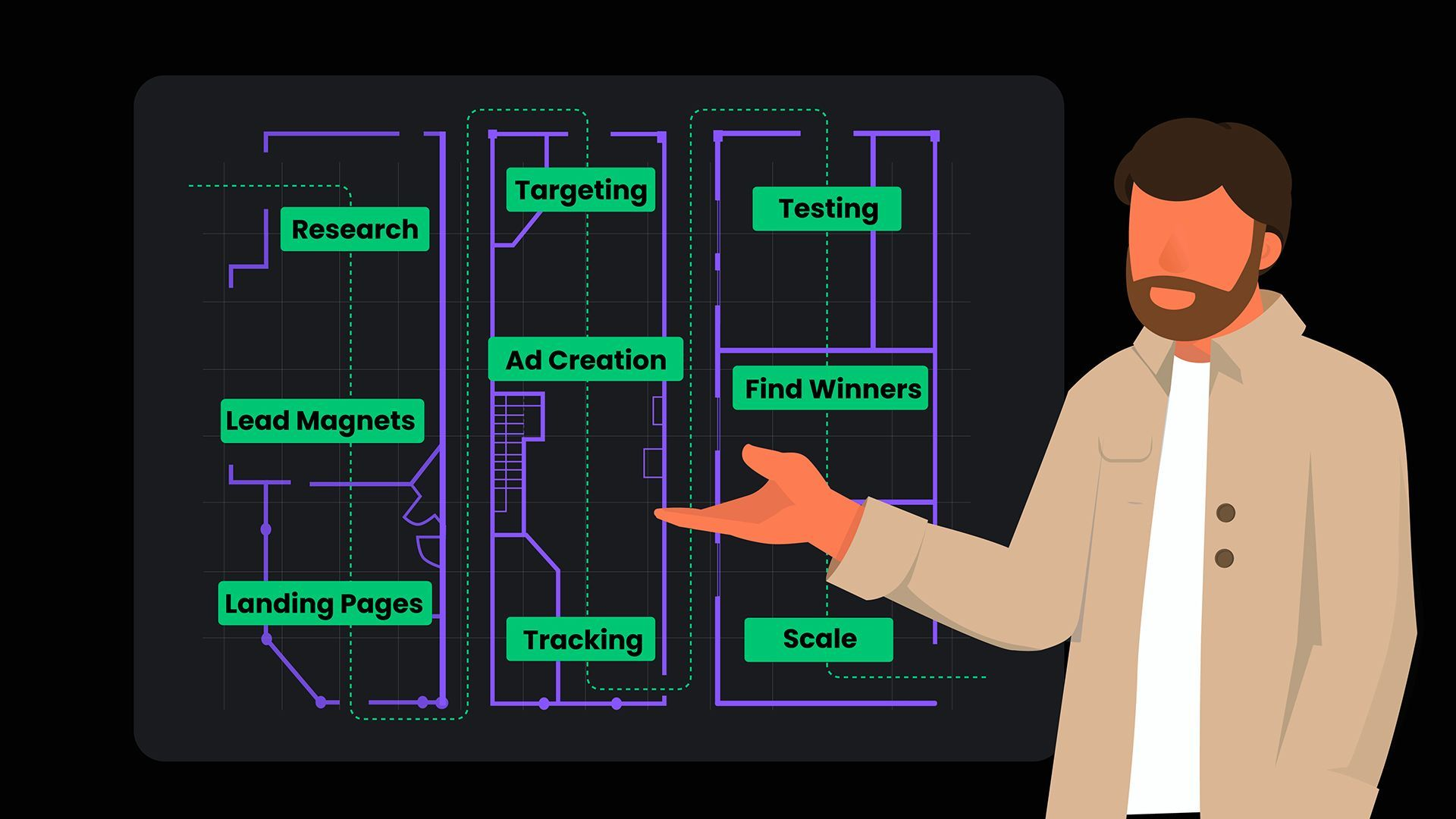
How to Get Started with Financial Services PPC Campaigns
Whether you're promoting personal loans, investment advice, or insurance policies, a well-crafted PPC campaign can put your offerings in front of the right audience at the right time.
This section will help you set up your ad campaign, showing you how to choose the best keywords and craft attractive ad copy.
➡️ Define your campaign objectives
Before launching your campaign, you should define your objectives. This will guide your PPC strategy and provide a benchmark against which to measure your success.
Here's how to set effective campaign objectives:
✅Identify business goals: Do you want to increase sales, generate leads, boost brand awareness, or drive traffic? Your campaign should contribute to these objectives.
✅Set targets: Make your objectives specific. Instead of aiming to "increase sales," set a target like "increase online sales by 20% over the next quarter."
✅Choose the right metrics: Determine which key performance indicators (KPIs) will best measure the success of your objectives. These might include click-through rates (CTR), conversion rate, cost per conversion, or return on ad spend (ROAS).
Your goals should be clear but flexible. Be prepared to change them as needed, based on what your campaign data shows and how the market changes.
➡️ Create your landing pages
After clicking on your PPC ad, a user will be directed to your landing page.
💡 This is where you can gain a massive advantage over your competitors.
Your landing page is where the customer decides whether or not to proceed with your company.
You only have around 5 seconds to really capture the users attention, or else they’re going to bounce off your site and try someone else.
Here's an example of a well-designed landing page in the financial industry:
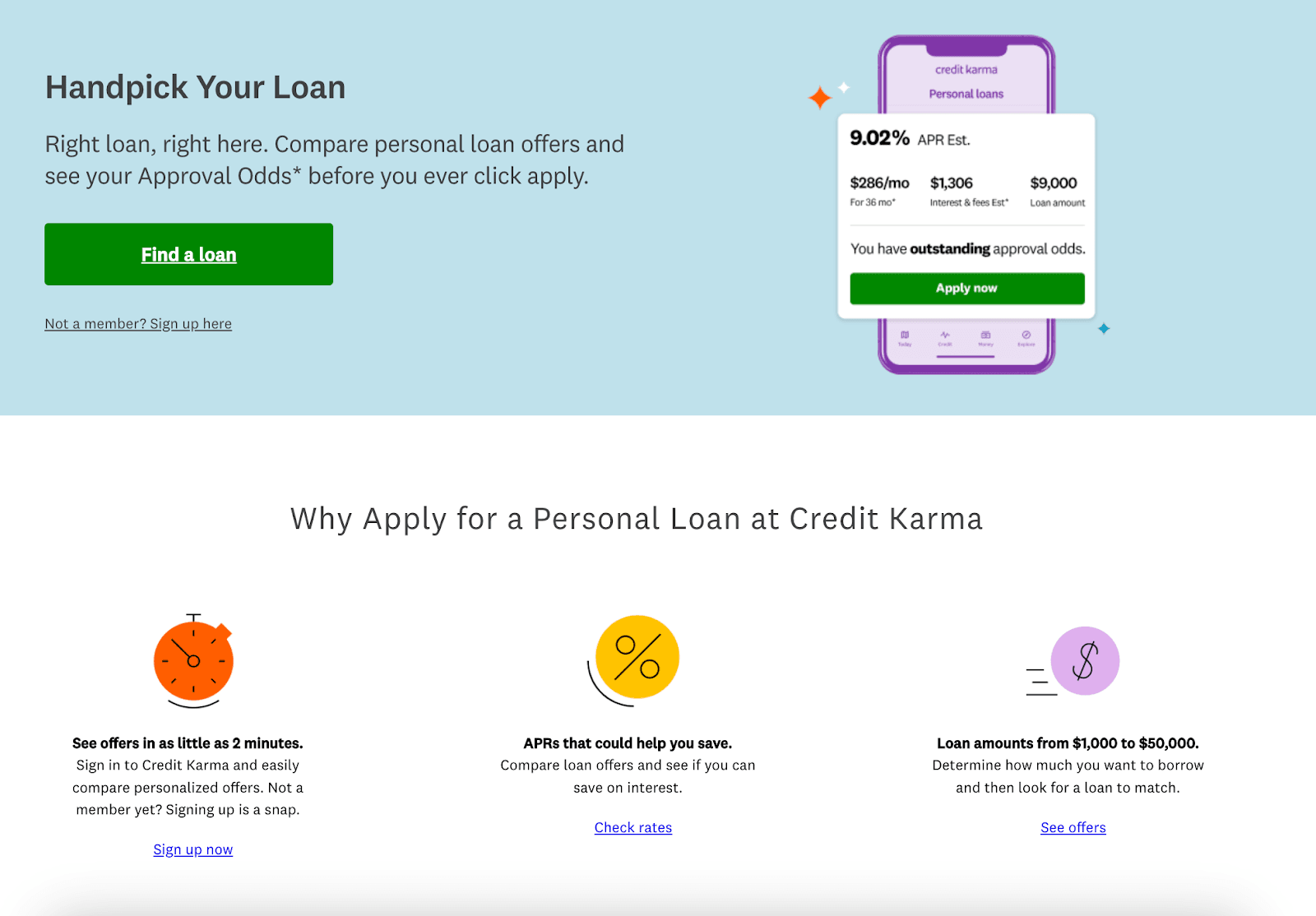
This is why it works:
✔️Unique value proposition (UVP): The headline "Handpick Your Loan" immediately tells the visitor that they can select a loan that fits their needs.
✔️Professional look and feel: The design is sleek and clean, making it suitable for the target audience of finance professionals.
✔️Strong call-to-action (CTA) The "Find a loan" button is prominent and placed in a contrasting color. This makes it stand out and encourages visitors to take the next step.
➡️ Create a Google Ads account
If you don’t already have one, creating a Google Ads account is the first step to launching a successful ad campaign.
It’s very simple to sign up and takes 5 minutes.
✅Visit the Google Ads website to complete this process.
➡️ Select your target audience
Reaching the right audience with the right message is a vital part of successful PPC campaigns.
Let’s say you're promoting retirement planning services.
Here’s how you might define your target audience:
✔️Age: Think about the group that's most interested in retirement planning. In this case, it's probably people aged 40-65, as they're more likely to be thinking about their retirement.
✔️Location: Consider where your financial services are available. Do you work in specific areas or across the entire country? Your target location matters.
✔️Income: People with different incomes have different financial needs. Tailoring your services to income brackets can help you find more relevant keywords and attract potential customers.
Defining your target audience is an ongoing process. As your financial services evolve and your client base grows, consistently reevaluate your target audience to ensure alignment with your goals.
➡️ Choose relevant keywords
When someone uses Google to search for a product, they type a specific word or phrase into the search bar. This is the keyword.
It’s extremely important to choose financial keywords related to your offerings. These are the keywords your PPC campaign will target.
Let’s say your financial services focus on retirement planning.
Here’s what your keyword research might look like:
✔️Core services: Start with keywords related to your main services. For retirement planning, this could include "retirement planning services,” or "retirement strategy."
✔️Special services: Do you have expertise in specific areas of retirement planning? Think about keywords like "401(k) optimization," "IRA management," or "pension planning."
✔️Client needs: Consider what phrases customers might use in their searches. Think about terms like "secure retirement," "financial independence," or "retirement income."
✔️Financial goals: Think about the financial goals of your clients. They might search for "early retirement planning," "wealth preservation," or "income during retirement."
To help you find the right keywords, use a research tool like Google Keyword Planner, Ahrefs, or SEMRush.
➡️ Bid on keywords
Keyword bidding refers to the amount you’re prepared to pay for a click on your PPC ad. The bidding process plays a key role in determining how and when your ad appears in search results for specific queries.
Here’s how it works:
✅Choose your keyword: Pick a keyword that you think people will use when they search for your product or service.
✅Set your bid: Decide how much you're willing to pay if someone clicks on your ad after they search for that keyword.
✅Ad position: When someone searches for your keyword, your ad might appear in their search results. If you bid more money, your ad could show up higher on the list.
Remember, a higher bid doesn't guarantee the best position or performance. Your bid must be balanced with a good Quality Score, which indicates how relevant and high-quality your ads and landing pages are in relation to the keyword.
➡️ Write compelling ad copy
Your ad copy needs to resonate with your audience by speaking directly to their desires, needs, and pain points.
It should be concise yet informative, delivering the message in a way that is easily understood.
Here’s an example of effective ad copy:

This is why it works so well:
✔️Keywords: The ad copy and headline use the keywords “personal loan” and “personal loans”. This ensures that the ad appears in front of potential customers who are interested in such services.
✔️Simplicity: The ad copy is easy to understand. It communicates the main points quickly: fast pre-approval for personal loans, the amount you can apply for, and that it won't impact your credit score.
✔️CTA: The ad invites the reader to apply online, which is a direct call to action that encourages engagement.
➡️ Track and refine your campaign
The work isn’t over once your PPC campaign is up and running.
The next steps are to track your campaign’s performance and refine your approach based on analytics and engagement data.
Here’s how to do this effectively:
✅Monitor key metrics: Keep a close eye on metrics such as click-through rate (CTR), cost-per-click (CPC), conversion rate, and Quality Score. These indicators will tell you how well your ads perform in relation to your goals.
✅Track your conversions: Conversion tracking is a free tool offered by Google Ads. Conversion tracking allows you to see which keywords and ads result in sales, sign-ups, or other desired actions.
✅Adjust bids: Regularly review your keyword bids. If certain keywords are performing well, you may want to increase your bid. If some are underperforming, you might lower your bid or pause those keywords.
✅Adjust targeting: Refine your targeting settings based on performance data. This includes adjusting demographics, locations, devices, and times of day to achieve the best results.
Remember, PPC is an iterative process that benefits from continuous optimization. By tracking and refining your PPC campaign, you can ensure your efforts get the best possible ROI.

Advanced PPC Tactics for Financial Services
Set up local service ads
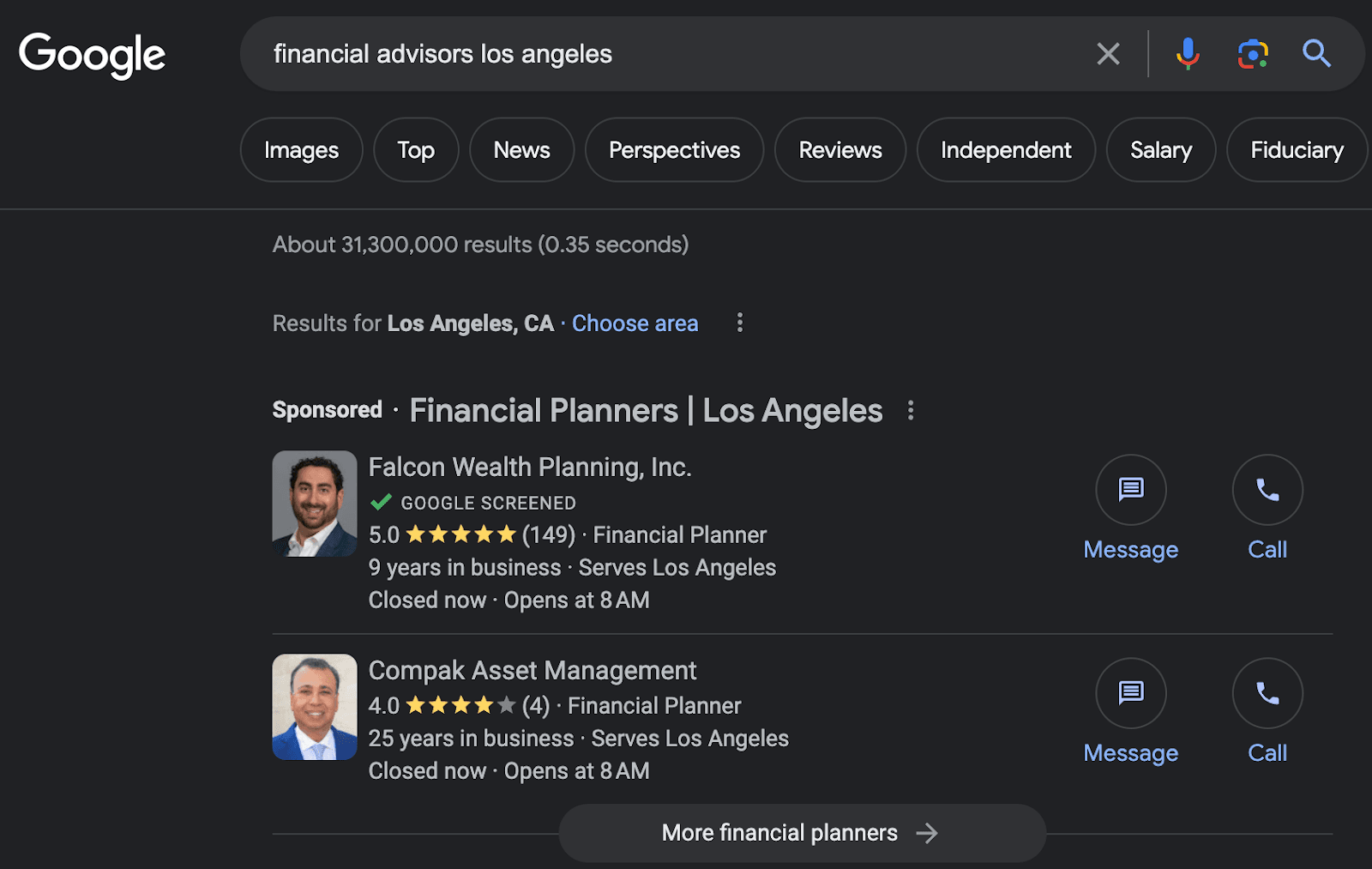
Local Service Ads (LSAs) are an effective way for financial service providers to reach local clients actively searching for their offerings.
Positioned at the top of Google search results and utilizing a pay-per-lead model, LSAs provide an affordable targeting solution.
Getting your business verified by Google is a necessary step, which then grants you either the Google Screened or Google Guaranteed badge, enhancing trust among potential clients.
This direct marketing method improves lead quality and ad effectiveness without unnecessary repetition.
Set up ad extensions
Ad extensions expand your ads with additional information, making them more prominent and providing relevant information upfront. For financial services, consider using:
➡️ Sitelink extensions: Direct users to specific pages of your website, such as service descriptions or an appointment booking page.
➡️ Call extensions: Allow potential clients to call you directly from the ad.
➡️ Location Extensions: Show your office location and hours to local searchers.
➡️ Callout Extensions: Highlight special offers or unique features of your service, like free consultations or 24/7 customer support.
Incorporate trust signals into your landing pages
Trust is a crucial factor in the financial services industry. Your landing pages should incorporate elements that build credibility and reassure potential clients.
This includes:
- Real stories from satisfied clients can significantly impact decision-making.
- Display any relevant certifications, accreditations, or awards your firm has received.
- If your service involves handling sensitive information, include badges from security audits or SSL encryption to reassure visitors of their data's safety.
Leverage video ads for your financial services
We love video ads at PPC.io.
Most companies simply don’t have the resources or knowledge to create video ads, so most companies just don’t use them.
This gives us a HUGE opportunity, because right now YouTube ads in particular are way cheaper than they should be, so we have a limited time opportunity to gain an edge on our competitors.
Video ads, with the highest click-through rate (CTR) at 1.84% are effective for explaining financial services and products in an engaging way.
Video ads also help build trust by adding a personal touch. Showing your team and sharing stories from happy customers can make potential clients feel more connected and confident about choosing your services.
Conversion Rate Optimization (CRO)
Conversion Rate Optimization (CRO) focuses on improving your website and landing pages to increase the likelihood of visitors completing actions such as filling out a form or scheduling a consultation.
CRO involves A/B testing different elements of your landing pages, such as headlines, form fields, and CTAs, to find the most effective versions.
Another key strategy is optimizing the user experience (UX) to ensure the site is easy to navigate, quick to load, and mobile-friendly.
Google allows advertisers to integrate third-party software into Google Analytics 4 to make this process easier.
Here are some platforms that we recommend:
Set up advanced conversion tracking
Advanced conversion tracking moves beyond just tracking final sales or lead submissions; it involves monitoring a range of micro-conversions that occur throughout the customer journey.
These micro-conversions can include actions like software demo requests, email newsletter sign-ups, and interactions with crucial pages on your website (e.g., pricing or product feature pages).
By tracking these actions, you gain insights into how users engage with your site and where they are in the sales funnel.
To effectively implement advanced conversion tracking, follow these steps:
1) Identify key micro-conversions: Determine user actions on your site that indicate interest in your offerings and might lead to a conversion. This includes activities such as downloading informational material, watching product videos, or engaging deeply with specific pages.
2) Implement tracking tools: Use platforms like Google Analytics and Google Tag Manager to monitor these micro-conversions. This involves setting up event tracking for actions like button clicks, form submissions, or significant page interactions.
3) Analyze user behavior: Examine the data to categorize user behaviors and segments. This analysis helps pinpoint which actions are strong indicators of potential conversions.
4) Optimize based on data: Apply insights from micro-conversion tracking to refine your PPC campaigns, website content, and design. You might need to adjust your budget allocation towards effective ads or modify your website to highlight key actions.
5) Continuously test and adjust: Regularly experiment with different strategies to improve the conversion pathway. Employ techniques such as A/B testing to compare the effectiveness of various optimization efforts on micro-conversions.
Summary
- Pay-per-click (PPC) advertising is a type of online advertising that financial businesses can use to get more leads and conversions.
- Perhaps the biggest benefit of PPC is that you only pay for each click you receive.
- The other key benefits of PPC for the financial industry include highly specific audience targeting, trackable results, and retargeting.
- Steps to follow to get your business’s PPC campaigns right include developing a strategy, creating your Google Ads account, and conducting keyword research.
